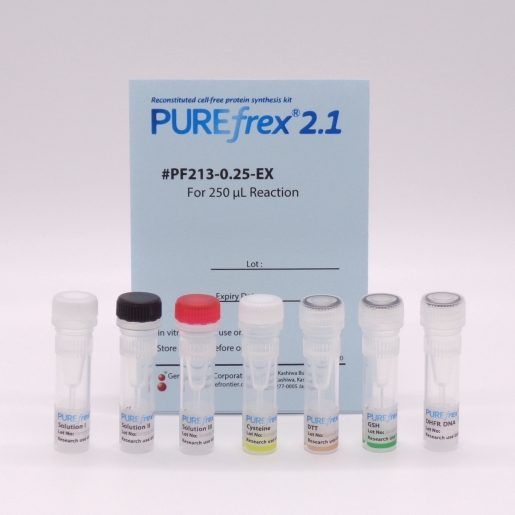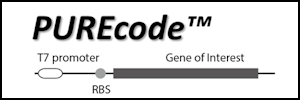[Information]
- Consultation is free of charge! DNA Design for PUREfrex®
- [Important] Notice of Material and Preparation Method Change
- Exciting New Release! 50 mL Scale PUREfrex® Kits
CONTENTS
Overview
PUREfrex® kit is a reconstituted in vitro Coupled Transcription/Translation Systems, completely different from an E.coli extract S30 system.
PUREfrex® is a series of newly developed reconstituted cell-free protein synthesis reagent based on PURE (Protein synthesis Using Recombinant Elements) system technology invented by Professor Takuya Ueda in the University of Tokyo.
PUREfrex®1.0 was launched in 2011, then we improved the protein productivity of PUREfrex®1.0 and the upgraded version PUREfrex®2.0 has been available since 2015.
PUREfrex®2.1 is newly launched in 2017 to make it possible for selecting a different reducing agent, while keeping other composition of PUREfrex®2.0.
Formation of a disulfide bond is an important process for folding and stability of secretory proteins such as enzymes or antibodies. A disulfide bond is usually formed by the oxidation of sulfhydryl group (SH-) of adjacent cysteine residues. Therefore, the formation efficiency of a disulfide bond depends on redox state. Additionally, disulfide bond isomerase which can catalyze the exchange of disulfide bridges may be also required for a correct pairing of cysteines.
The redox state in the reaction mixture of PUREfrex® is affected by the type of reducing agent and the ratio of reducing and oxidizing agent. PUREfrex®2.0 contains dithiothreitol (DTT) in Solution I as reducing agent. In contrast, it is possible to select a suitable reducing agent for the protein of your interest by using PUREfrex®2.1, in which reducing agent is not added to Solution I. PUREfrex®2.1 includes Solution I neither DTT nor Cysteine. Each solution of cysteine, DTT and reduced glutathione (GSH) is attached to the kit independently. Other reducing agents such as 2-mercaptoethanol can be also used.
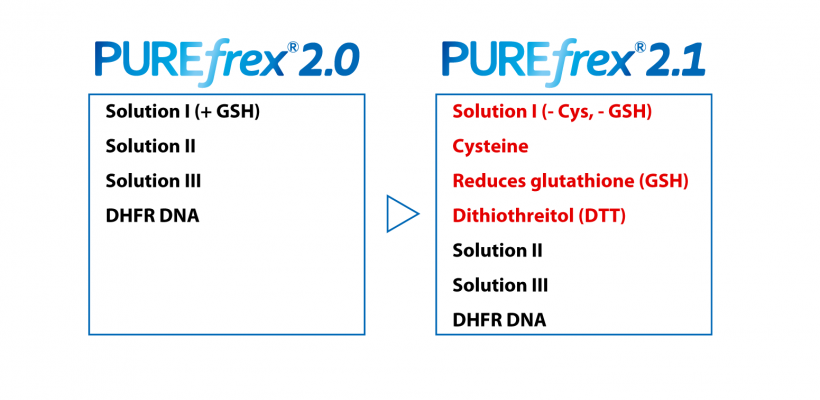
Specifications
Kit components <PUREfrex® 2.1>
| Reagent | Quantity for 250 μL rxn |
Quantity
for 2 mL x 5 rxn |
Description | Storage *1 |
|---|---|---|---|---|
| Solution Ⅰ | 100 μL | 800 μL x 5 | Amino acids, NTPs, tRNAs and substrates for enzymes etc. | -20 °C |
| Solution Ⅱ | 12.5 μL | 100 μL x 5 | Proteins in 30 % glycerol buffer | -20 °C or -80 °C *2 |
| Solution Ⅲ | 25 μL | 200 μL x 5 | Ribosome (20 μM) | -80 °C*2 |
| Cysteine | 20 μL | 160 μL x 5 | Cysteine (10 mM) |
-20 °C |
| DTT | 20 μL | 160 μL x 5 | Dithiothreitol (40 mM) |
-20 °C |
| GSH | 20 μL | 160 μL x 5 | Reduced glutathione (80 mM) |
-20 °C |
| DHFR DNA *3 | 10 μL | 10 μL x 1 | PCR product containing a gene encoding dihydrofolate reductase (DHFR) from E.coli as a positive control. (20 ng/μL) | -20 °C |
- Indicated temperature shows storage temperature after opening the kit. Please store the kit at -80 °C before opening.
- The rest of solution should be frozen rapidly in liquid nitrogen or dry ice/ethanol, and be stored at -80 °C. Divide into aliquots, if necessary, and avoid refreeze and thaw as much as possible.
- For synthesizing DHFR, add 1 µL of DHFR DNA to 20 µL of reaction. Sequence of DHFR DNA is here.
How to aliquot
PUREfrex® kits are highly stable during storage at -80°C. However, repeated freeze-thaw cycles can lead to a reduction in activity. If only small amounts are required per use, we recommend aliquoting the product into smaller portions for storage. When aliquoting small volumes, using low-binding tubes is advisable to minimize loss and ensure reliability.
[Solution I]
Thaw the solution by incubating it at room temperature or 37°C for approximately 5 minutes and mix thoroughly until it becomes completely clear. Aliquot the solution without placing it on ice and freeze the aliquots at -20°C or below.
[Solution II]
Thaw the solution on ice and mix thoroughly (for small volumes, gentle vortexing is acceptable as long as it does not create bubbles). Aliquot the solution and rapidly freeze the aliquots using liquid nitrogen or a freezing mixture of dry ice and ethanol. Finally, store them at -20°C or below.
[Solution III]
Thaw the solution on ice, avoiding extended exposure to the thawed state. Mix thoroughly, aliquot the solution, and rapidly freeze using liquid nitrogen or a freezing mixture of dry ice and ethanol. Store the aliquots at -80°C. Avoid freezing directly in a -80°C freezer without rapid freezing, as this can result in decreased activity.
Note
PUREfrex® is developed for in vitro research only. PUREfrex® should not be used for the therapy, diagnostic or administration to animals including human and should not be used as food or cosmetics etc. To avoid the contamination of nuclease, nuclease-free-treated water, reagents and materials should be used. We also recommend wearing gloves and mask.
“PUREfrex® is Registered in U.S. Patent and Trademark Office”
Experiment Workflow
General procedures for using PUREfrex® to synthesize functional proteins are shown in Figure.
Start by preparing the template DNA suitable to the protein synthesis with PUREfrex® and examine whether the protein of interest is synthesized. Redesign the nucleotide sequence of the template DNA if too little protein is synthesized. Add supplement such as molecular chaperones or changing the synthesis conditions if the solubility or activity of the synthesized protein is low or absent. The kit contains enough reagents for examining whether the target protein can be synthesized.
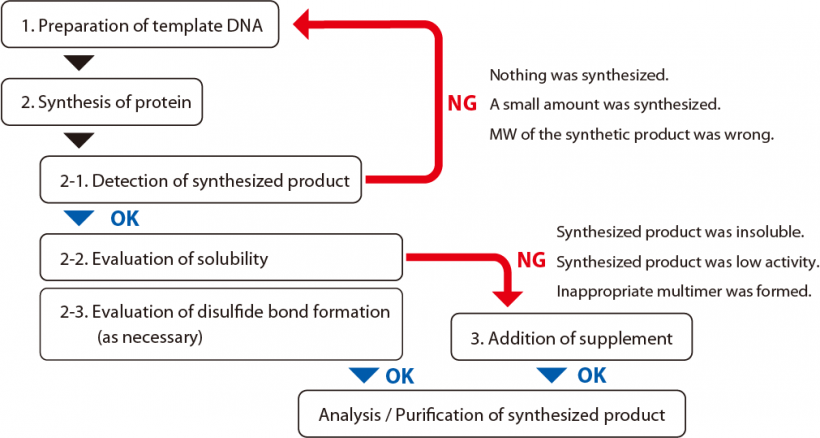
Protocols
This is a standard protocol for synthesizing proteins containing disulfide bonds. Therefore DsbC Set is also used with PUREfrex®2.1. GSSG and DsbC are included in DsbC Set. When you synthesize proteins without disulfide bonds, please add DTT instead of GSH and no DsbC Set.
1. Thaw Solution I, Cysteine, GSH and GSSG by incubation at room temperature or 37 °C for 5 minutes for completely dissolving, and then leave at room temperature.
2. Thaw Solution II, III and DsbC on ice.
3. Mix each solution by vortex and centrifuge briefly to collect solution at the bottom.
4. Assemble the reaction mixture in a tube as follows. Add the template DNA to 1 - 3 ng/µL per 1 kb.
| Water | 5-X μL |
| Solution I | 8 μL *1 |
| 10 mM Cysteine *2 |
1 μL |
| 80 mM GSH *2 |
1 μL |
| 60 mM GSSG |
1 μL |
| Solution II | 1 μL |
| Solution III | 2 μL |
| 80 µM DsbC *3 |
1 μL |
| Template DNA *4 | X μL |
| Total | 20 μL |
|---|
5. Incubate the tube at 37 °C for 4 - 6 hours with heat block or water bath.
Protein synthesis reaction is almost done until 6 hours, but some proteins require longer incubation (e.g. 24 hours) to form disulfide bonds between the correct pair of cysteine residues.
6. Analyze or use the synthesized products.
- This volume is different from Solution I of PUREfrex®2.0.
- In PUREfrex® 2.1, you can freely adjust the amount of reducing agents (Cysteine, DTT and GSH, etc.), but be sure to add Cysteine, which is a material of protein.
- DsbC is diluted with Dilution buffer included in DsbC Set.
- Please visit the template DNA preparation site.
Video - How to use PUREfrex -
Applications
Tech Notes
Synthesis of E.coli acid phosphatase (AppA)
AppA contains four consecutive and one nonconsecutive disulfide bonds. Its productivity and enzyme activity were compared when it was synthesized using PUREfrex®2.1 with DTT or GSH as reducing agent.
Synthesis of IgG
Active immunoglobulin G (IgG) forms a “Y”-shaped conformation, which consists of two heavy chains (HC) and two light chains (LC) connected by disulfide bonds. The productivity of HC and LC and the formation efficiency of Y-shaped IgG were compared when they were synthesized using PUREfrex®2.1 with different reducing agents.
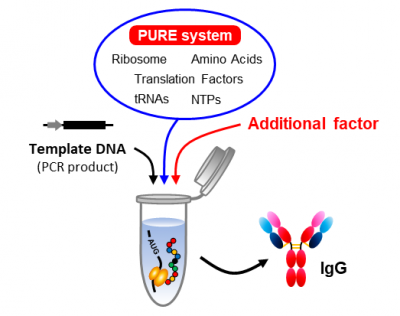
Resources
On the Resources page, you can find posters and technical notes about PUREfrex®.
Additionally, there are papers that use PUREfrex® or PURE system technology.
Related Products
When your protein needs an assistance of molecular chaperone or a formation of a disulfide bond to form a correct conformation, we have supplemental reagents by simply adding to PUREfrex®2.1.
Cell-free Protein Synthesis Kits
Supplements – Chaperones –
These are supplement for PUREfrex® which is molecular chaperone to be aggregate-prone protein in a soluble form.
Supplements – Forming disulfide bonds –
This is supplement for synthesizing proteins containing disulfide bonds in an active form.

